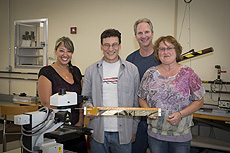SiDet group completes detectors for Brookhaven experiment
 |
This team of technicians helped construct new silicon detectors for Brookhaven's STAR experiment. From left: Michelle Jonas, Humberto Gonzalez, Gordon Gillespie and Tamara Hawke. Not pictured: Michael Roman. Photo: Reidar Hahn |
In the first millionths of a second of the universe's life, protons and neutrons—the particles that make up matter—didn't exist. Instead, there was simply a hot, dense soup of even smaller particles known as quarks and gluons.
Scientists working on Brookhaven National Laboratory's STAR experiment have been studying this soup, known as quark-gluon plasma, for over a decade. Now, contributions from Fermilab's Silicon Detector Facility, or SiDet, are helping to further unveil the mystery of the moments after the big bang.
The team at SiDet has been constructing silicon detectors for about 28 years. The detectors are particularly adept at examining particle events close to the interaction point. When two particles collide, new particles are sent scattering in all directions. The point at which they split is known as the primary vertex. Sometimes, the new particles divide further, creating what are called secondary vertices.
"Usually if you want to measure things that happen very close to the region of the vertices you use silicon detectors," said Gaston Gutierrez, a scientist at SiDet.
This is what the team at the STAR experiment aims to do. They want to study the quark-gluon plasma by looking at heavy flavor particles generated in the heavy-ion collisions, but up until now have not had the resolution to do so.
The STAR collaboration intended to build new silicon detectors to increase the resolution, but risked falling behind schedule—it needed more manpower. So physicist Zhenyu Ye, an assistant professor at the University of Illinois at Chicago who joined STAR in 2012, called upon Gutierrez, one of his supervisors when he was a postdoc at Fermilab, to see if SiDet could provide help for this project. The lab agreed.
At SiDet, a team of five Fermilab technicians—Bert Gonzalez, Tammy Hawke, Michelle Jonas, Gordie Gillespie and Michael Roman—built and measured 18 detectors—known as staves—for STAR. Each stave is a long, rectangular carbon fiber core with six silicon sensors and 36 readout chips. Beams are fired through the sensors, and readout chips at one end of the detector pick up and analyze the signals released.
The work is incredibly precise. Gonzalez, for example, mounts the readout chips and silicon sensors onto the core by hand, using a microscope to make sure everything is aligned properly.
"It's always, 'Wait until you receive the parts, then hurry up and get it done,'" Gonzalez said. "But of course haste makes waste. It's best to do it right the first time."
Now that the 18 staves are completed, they will be installed onto a supporting structure, which will be integrated into the STAR experiment sometime in September.
"Help from Fermilab is really great for the project, because otherwise it may not have been finished on time," Ye said. "These people are some of the most experienced at assembling silicon detectors in the world. We are just fortunate to have them help us."
—Laura Dattaro
|